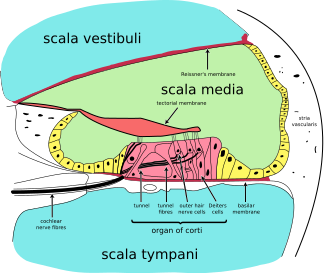| Perilymph | |
|---|---|
 Cross-section of cochlea. Perilymph is located in the scala vestibuli and scala tympani - the aqua regions at the top and bottom of the diagram. | |
 Cross-section of semi-circular canal and duct showing perilymphatic space | |
| Details | |
| Identifiers | |
| Latin | perilympha |
| MeSH | D010498 |
| TA98 | A15.3.03.056 |
| TA2 | 6938 |
| FMA | 60908 |
| Anatomical terminology | |
Perilymph is an extracellular fluid located within the inner ear. It is found within the scala tympani and scala vestibuli of the cochlea. The ionic composition of perilymph is comparable to that of plasma and cerebrospinal fluid. The major cation in perilymph is sodium, with the values of sodium and potassium concentration in the perilymph being 138 mM and 6.9 mM, respectively. [1] It is also named Cotunnius' liquid and liquor cotunnii for Domenico Cotugno.